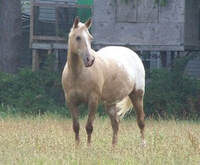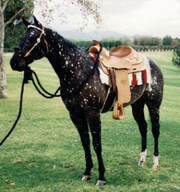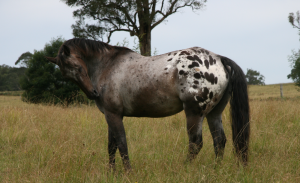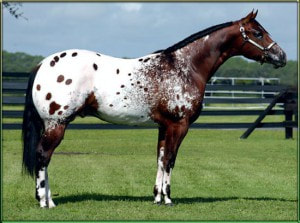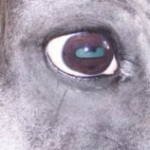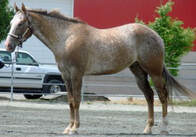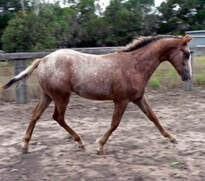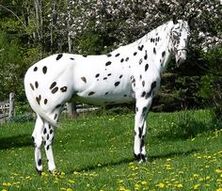REGISTER YOUR APPALOOSA
To quickly register your appalossa please download the one step registration from from the forms section
Why register your Appaloosa?
There is no better way to ensure the value of your Appaloosa then to register it with the Appaloosa Horse Association - New Zealand's official breed registry.
An Appaloosa registration certificate acts as an identification card giving you proof of appearance, brands, age, parentage and compliance to breed standards.
Download a copy of the ApHANZ Handbook your ultimate reference guide when reviewing a horse's eligibility for registration
How to register your Appaloosa
To register your Appaloosa, please download and complete the one step registration form and send in with required paperwork, photos and fee paid online.
IMPORTANT INFORMATION REGARDING FILLING OUT THE FORMS
A registration certificate is an official document so it's important that it is filled out truthfully, accurately and completely.
One of the most tricky aspects is accurate identification of your Appaloosa's colour and coat pattern, so to help out we have examples for you to refer to. Remember, accurate recording each of your horse's markings is vital
There is no better way to ensure the value of your Appaloosa then to register it with the Appaloosa Horse Association - New Zealand's official breed registry.
An Appaloosa registration certificate acts as an identification card giving you proof of appearance, brands, age, parentage and compliance to breed standards.
Download a copy of the ApHANZ Handbook your ultimate reference guide when reviewing a horse's eligibility for registration
How to register your Appaloosa
To register your Appaloosa, please download and complete the one step registration form and send in with required paperwork, photos and fee paid online.
IMPORTANT INFORMATION REGARDING FILLING OUT THE FORMS
A registration certificate is an official document so it's important that it is filled out truthfully, accurately and completely.
One of the most tricky aspects is accurate identification of your Appaloosa's colour and coat pattern, so to help out we have examples for you to refer to. Remember, accurate recording each of your horse's markings is vital
Base Colour: Choose from the following base colours to describe your Appaloosa:
Dun vs. buckskin: dun horses have a dark dorsal stripe along their spine and often have stripes on their legs and forequarters.
- Brown
- Bay
- Chestnut
- Dun
- Buckskin
- Grulla
- Black
- Palomino
- Cremello
Dun vs. buckskin: dun horses have a dark dorsal stripe along their spine and often have stripes on their legs and forequarters.
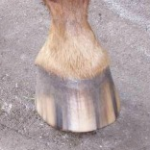
Striped Hooves
Indicate whether your Appaloosa has vertical stripes on its hooves, for each hoof. These are alternating dark and white stripes on hooves on legs which do not have white leg markings.
Indicate whether your Appaloosa has vertical stripes on its hooves, for each hoof. These are alternating dark and white stripes on hooves on legs which do not have white leg markings.
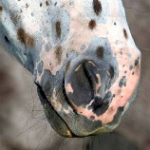
Mottled Skin
Indicate whether your Appaloosa has mottled/speckled skin on its muzzle, around its eyes and/or genitals.
Indicate whether your Appaloosa has mottled/speckled skin on its muzzle, around its eyes and/or genitals.
Leg Markings:
Choose from the following to indicate how far up your Appaloosa's legs white markings exist, for each leg:
Face Markings:
Choose from the following to indicate how far up your Appaloosa's legs white markings exist, for each leg:
- Heel: a white marking across the entire heel or just on one side.
- Coronet: the first 2.5 centimeters above the hoof, extending all the way around the foot and including the heel.
- Pastern: extends from the top of the hoof to the bottom of the fetlock joint.
- Fetlock: extends from the top of the hoof to the top of the fetlock joint.
- Half-stocking: extends from the top of the hoof to the midway point of the cannon bone.
- Stocking: covers the leg extending from the top of the hoof to any point above the knee or hock.
Face Markings:
- Star: on the forehead, in the area above the eyes. If there are two white marks on the forehead, the most distinct is referred to as a star, while the other is simply a white mark, referenced in location to the star.
- Stripe: a vertical marking below eye level and above the nostrils.
- Snip: below the nostrils, down to and including the lower lip.
- Blaze: a combination of all the above, beginning above the eyes and ending below the nostrils.
- Bald face: a large blaze extending outside the eyes, covering the width of the bridge of the nose and over the entire muzzle.
